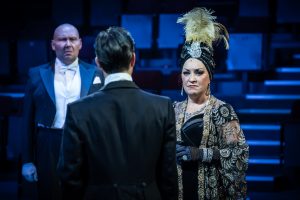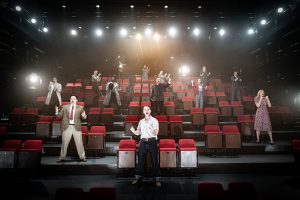Director's Note: Nikolai Foster on Sunset Boulevard in Concert - at Home

In this Director’s Note originally written in December 2020, Artistic Director Nikolai Foster shares his vision for our first-ever fully online Made at Curve show, including how we adapted the show for the digital stage and other details you can expect from our streamed version of Andrew Lloyd Webber’s musical masterpiece.
Our concert production of Sunset Boulevard reunites our 2017 company, led by acclaimed British musical theatre stars Ria Jones – who, coincidentally, was the first artist to perform Norma Desmond at Sydmonton when Andrew first presented the piece in 1991 – and Danny Mac. It is performed in-the-round, with the company dressed in Colin Richmond’s stunning costumes and lighting design by our Curve Associate Ben Cracknell. I’m personally thrilled to be revisiting the show for this new concert staging, with choreography by Lee Proud and Musical Supervision by Stephen Brooker.

Our school used to run a coach down to London for theatre trips a couple of times each year. Inexplicably the trips were arranged by our very tough PE teacher, who in addition to terrorising us on the football pitch, had a love for theatre, especially musicals and arranged the trips. I first saw Sunset Boulevard on one of these trips at the Adelphi with Petula Clarke as Norma Desmond, in 1995. I had never seen anything like it – I remember being electrified by the music and totally and utterly spellbound by John Napier’s astonishing design, which conjured Hollywood sound stages, car chases and Norma’s mansion in the flash of a lighting cue. It was a million miles away from my life in West Yorkshire. I fell in love with the show then and sitting at the back of the Adelphi stalls that day, could never have imagined I would one day have the honour of directing the piece, collaborating with such an accomplished team of designers, technicians, musicians and actors. Sunset is a remarkable piece of writing, with Andrew, Christopher Hampton and Don Black effortlessly capturing the vibrancy, violence, aspiration and passion of 1950s Hollywood. The music and words tell us everything we need to know and like the silent movies of Norma’s day, ride the full spectrum of humanity through ingenious narrative and structure.
We originally presented our production of the play in 2017. After opening at Curve, producers Michael Harrison and David Ian toured the show across the UK and Europe. It was a large-scale production, with a constantly moving set, hundreds of lighting cues and costumes changing so fast it would even set Edith Head into a spin. I approached it like a film and always imagined I was directing a live film onstage, seeing each scene and transition through a crane shot, close up or steadicam. The story is narrated by Joe and it would be easy to assume it is a story entirely of his making, but this time around I also wondered if it was entirely of Norma’s imagination. Who is to say what is reality and what is fiction (especially seen through our 2020 eyes of turmoil and unprecedented upheaval). Norma speaks to us directly at the end and seems to be entirely in control of her world, destiny and the players around her.

In our original production, we played with the idea of creating a naturalistic environment, with realistic interiors and projected exteriors suggesting a world beyond, and then shattering it, revealing the artifice of both theatre and film making. We saw rooms deconstructed in front of us, revealed to be flats and props on a Hollywood soundstage. Our 2020 filmed concert, created in extraordinarily challenging circumstances, picks up where the 2017 production left off – as a team we have developed the ideas we used in 2017 and taken them further : In our huge empty theatre (which has the scale and beautiful atmosphere of a Hollywood soundstage), with only our actors, musicians and the music and lyrics, we delve deeper into the psychology of the characters and have found imaginative new ways to tell this story together. The camera is an active participant, fully realising the movement and devices we used a few years back.

Our 2020 concert was originally due to take place in our new auditorium, especially created for a season of work which supports social distancing. Curve is unique in that its 900-seat and 400-seat auditoria can be combined to create a spectacular 1300-seat, in-the-round single auditorium, which offers approximately 500 seats with social distancing. Cameron Mackintosh kindly gifted us a revolving stage which we installed for the season, beautifully bringing the spaces together and creating a stage which is both epic and intimate.

When it became apparent we would no longer be able to perform to a live audience (half way through technical rehearsals!), we quickly adapted our concept and wanted to create a filmed experience which fully embraced the cameras and art of film-making. As Sunset is a play all about the birth of the motion picture industry and celebrates the creative experience, this feels like the perfect piece to challenge ourselves creatively, fusing theatre and film in an imaginative way. Rather than the cameras filming the action onstage as passive observers, we want to immerse them in the action and make the cinematic language central to our narrative, so the cameras become additional characters. When working with the camera team, especially the Gimbal Operator Mbili, we would often talk about the way his camera moves in emotional and character terms. Mbili may move decisively and dynamically to Joe for narration, but sweeps majestically to Norma.

Andrew’s music and Christopher’s script are so filmic, using the cameras and combining them with our epic space, mean we were only ever limited by our imaginations. The music is so vivid and clearly tells us where to “cut” or when to transport the audience to another scene. As the mighty Hal Prince suggested, if you can’t “see” a piece of theatre, you can’t “hear” it. – If our staging and camera work doesn’t match the dynamic of the music, the visual and sound will jar. It’s always a dream to work on an Andrew Lloyd Webber show because they’re always theatrically bold, musically innovative and enable a director and production team to be imaginative and attempt to match the brilliance of the writing.
Our orchestra was due to be seated in our biggest rehearsal room, so they could all be safely distanced. As we no longer have an audience, we have relocated our talented musicians to the stalls – the seats have been removed, placing the orchestra in the same space as the actors, which looks stunning on film. Isn’t it strange how orchestras for musicals often go in the pit? Music is the heart of the piece and it’s always great to see the musicians. In a piece like Sunset, seeing the musicians inhabit their instruments and every single note in the same way Ria, Danny and the actors do onstage is a tribute to Stephen Brooker’s extraordinary approach to his work : Stephen directs the orchestra through character, so every beat is a desire, feeling or need expressed by the character through music.

Though performed as a concert, the show retains the atmosphere, style and ambition of our original, award-winning production. It is fully rehearsed with the actors off-book, and – without an audience present – we have utilised every inch of our remarkable space. For example, Norma first appears from the back of our dress circle, descending the staircase as she did in our original production. The ensemble inhabit the empty seats throughout the piece, studio hands watching the scenes play out in front of them or representing the 2020 audience who never came. Joe’s garret is played on our fly tower gallery, providing a visual metaphor in contrast to the grandeur of Norma’s mansion. Essentially it’s a love letter to our theatre, the joy of working in the creative industries and the technicians and artists who create the work.
We have been working with local film company Crosscut Media to film the concert and have used our original video designer Douglas O’Connell’s imagery (originally projected in our fully-staged production), to help suggest location and cut into our final edit to create further atmosphere and support scene changes. It’s been a joy to blend these aspects and the animated content has proved to be a wonderfully helpful bridging device between stage and screen.
Though nothing compares to the feeling of being together at Curve and the thrill of live theatre, we are thrilled to have this opportunity to digitally share the immense talents of our actors, creatives, freelancers, technicians and everyone else involved in creating this production. On behalf of Chris Stafford and myself, we’d like to a say a huge thank you to the army of freelancers who have lent there exceptional, truly world-class talents to this production. Without the freelancers (actors, musicians, creative team, stage managers, sound techs – the hundreds of names you will read on the end credits) theatre simple doesn’t exist. And to our Curve team, who have effortlessly risen to every challenge – from rigging sound monitors so we could play scenes on our fly gallery to hiding cameras on fly wires above the stage, there is nothing the highly skilled technicians at Curve cannot achieve together.
Sunset Boulevard in Concert – at Home is made with love, a festive gift for all of our audiences “out there in the dark”.

Sunset Boulevard – at Home returns for one week only from Mon 10 – Sat 15 May, in support of The Andy Nairn Bursaries in Technical Theatre, with household tickets priced at £20. To book, please click here. For further details about the stream and what to expect, please click here.
This production was made possible thanks to support from Really Useful Group, Paramount Pictures, UK Theatre, the Musicians’ Union, our sponsors PPL, supporters Holiday Inn and the Culture Recovery Fund.